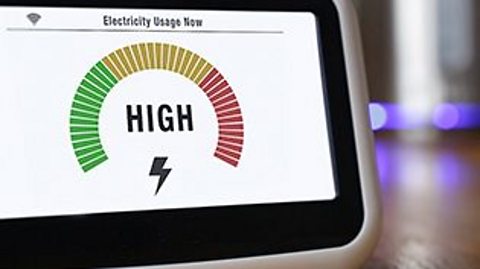Key points
Much of the energy that is transferred in our homes is supplied by electricity.
Energy resources are used to generate electricity.
Some energy resources are renewableEnergy resources that can be easily replenished or are effectively limitless. These resources will not run out by being used. Solar power is an example of a renewable energy resource. and some are non-renewable resourceA resource that will run out, e.g. oil, natural gas, coal. These sources cannot be replaced by nature in less than a human lifetime..
Generating electricity
Much of the energy that is transferred in our homes is supplied by electricity. There are a wide range of energy resources used to generate electricity.
Energy resources are systems that can store large amounts of energy. Energy resources can be divided into two categories:
Renewable resources - energy resources that can be replenished. They do not run out although we are using them.
Non-renewable resources - energy resources that cannot be replenished. These resources will eventually run out because we are using them.
Not all energy resources are available everywhere and each one has its own advantages and disadvantages.
When some energy resources are used, carbon dioxide gas is released into the atmosphere. Carbon dioxide is a greenhouse gasThe gases responsible for global warming - carbon dioxide, methane, nitrous oxide and CFCs (chlorofluorocarbons).. The vast majority of scientists say that increasing amounts of carbon dioxide in the atmosphere are causing global warmingThe rise in the average temperature of the Earth's surface.. Global warming is causing a number of serious problems, including:
- Polar ice melts
- Sea levels rise, causing floods near coasts
- More frequent storms
- Drought and wildfires.
Renewable energy - wind
Wind is an example of a renewableEnergy resources that can be easily replenished or are effectively limitless. These resources will not run out by being used. Solar power is an example of a renewable energy resource. resource. Wind is caused by the movement of air. The wind turns a wind turbineRevolving machine with blades that are turned by wind, water or steam. Turbines in a power station turn the generators. which generates the electricity.
Advantages and disadvantages of wind
Advantages
Wind is a renewable energy resource.
Wind power does not release any carbon dioxide.
There are no fuel costs involved in running a wind turbine.
Disadvantages
Wind turbines can make a lot of noise and some people do not like to live near them because of this.
Some people think that wind turbines spoil the landscape.
Wind is an unreliable energy resource - the amount of electricity that is generated is dependent on how windy it is.
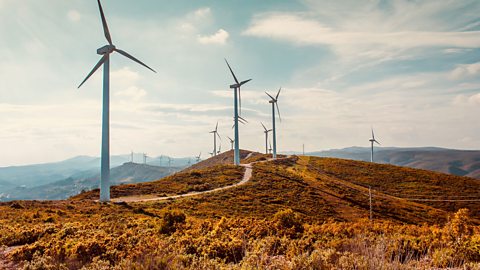
Renewable energy - water
Water is an example of a renewableEnergy resources that can be easily replenished or are effectively limitless. These resources will not run out by being used. Solar power is an example of a renewable energy resource. energy resource.
Like wind, moving water can also be used to turn a turbineRevolving machine with blades that are turned by wind, water or steam. Turbines in a power station turn the generators.. The turbine can then turn a generatorDevice that is made to rotate by mechanical working. It transfers energy out by electrical working. .
There are several different energy resources involving water:
tidal
wave
hydroelectric
Tidal
Huge amounts of water move in and out of river mouths each day because of the tides.
A tidal barrage is a barrier built across a river estuary. The barrage contains electricity generatorDevice that is made to rotate by mechanical working. It transfers energy out by electrical working. , which are driven by the water rushing through tubes in the barrage.
Wave
The water in the sea rises and falls because of waves on the surface.
Wave machines move with the waves to drive generators.
Hydroelectric
Like tidal barrages, hydroelectric power stations use moving water. Water is held behind a dam built across a river.
The water high up behind the dam has a lot of energy in the gravitational potential energy store. This is transferred to the kinetic energy store as the water rushes down through tubes inside the dam. The moving water turns a turbineRevolving machine with blades that are turned by wind, water or steam. Turbines in a power station turn the generators. that drive generators.
Advantages and disadvantages of using water as an energy resource
Advantages
There are no fuel costs.
Water power does not release any carbon dioxide.
Hydroelectric and tidal are reliable sources of power.
Disadvantages
Waves are not a reliable source of power. Waves are not consistent and a calm period means there are not waves to generate power.
Building dams and tidal barrages can harm habitats and displace people from their homes.
Renewable energy - geothermal
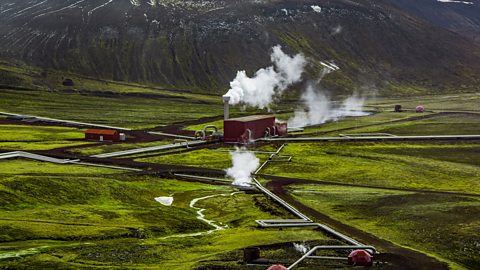
Geothermal energy resources are an example of renewableEnergy resources that can be easily replenished or are effectively limitless. These resources will not run out by being used. Solar power is an example of a renewable energy resource. energy resources.
Hot water and steam from deep underground can be used to turn a turbineRevolving machine with blades that are turned by wind, water or steam. Turbines in a power station turn the generators. which turns a generatorDevice that is made to rotate by mechanical working. It transfers energy out by electrical working. to generate electricity.

Video
Watch the video to understand more about geothermal energy.
Find out how the heat of the Earth can be used to generate clean electricity
Have you ever thought about how much energy there is underground? Enough to boil underground water until it erupts forcing steam and water high into the air. It doesn’t just look spectacular, it’s a great source of usable energy: geothermal energy.
‘Geo’ means earth and ‘thermal’ means heat. So geothermal energy is generating energy from the Earth’s heat, and is a great source of renewable energy.
So, how does it work? Deep below the surface of the Earth is the Earth’s mantle – a layer of hot, molten metal. Heat from the mantle rises up through the Earth’s crust. Where the crust is thinnest, this heat gets much closer to the surface. In some places it heats up water in underground lakes and reservoirs.
Geothermal energy plants use this hot water to generate electricity. Pipes are drilled down to these water stores. The water is so hot that it produces steam which rises up through the pipes and is used to turn the blades of turbines. The turbines drive generators that generate electricity to power homes and businesses.
The best bit is that after the steam has powered the turbines it can be cooled until it condenses back into water and then pumped back down to be reused and heated again.
In some volcanic regions, like Iceland, geothermal energy is so close to the surface and easy to tap into that the heat is used for other things other than generating electricity. In Iceland’s capital, Reykjavik, some of the geothermal energy provides hot water that runs in pipes underneath some roads, pavements, and car parks. As well as making pedestrians feel warm in freezing winter temperatures, this melts snow and keeps roadways clear. Something we could use over here in Scotland. Amazingly, Iceland gets more than a quarter of its electricity generation from geothermal sources.
Stuart Gilfillan, Geochemistry Lecturer, University of Edinburgh: A really important thing about geothermal energy in terms of its renewable capabilities is that it’s available twenty-four hours a day, three-hundred and sixty-five days a year. So the Earth’s heat is there and it’s available all the time, and that’s a contrast to wind power which is obviously not there if the wind doesn’t blow.
In solar power, another big renewable source, clearly that doesn’t work very well at night when the Sun isn’t shining. Generally, geothermal power plants are available about 90-odd percent of the time, and that’s even higher than most fossil fuel power plants, which would operate for about seventy-five percent of the time.
So, what’s the catch? Geothermal energy is limited to only a few places around the world that are volcanically active. These include places on the Ring of Fire, like the west of the USA, Indonesia, New Zealand, and Japan. On top of this, it is expensive to build these plants in the first place.
Also, when building these plants, the digging to get to the geothermal energy releases greenhouse gases. While they’re nowhere near as bad as fossil fuels, the gases still count.
How would you like to live in a city that is warm in the freezing depths of winter?
Geothermal resources come from either volcanic areas or hot rocks.
Volcanic areas
Several types of rock contain radioactive substances such as uranium. During nuclear or radioactive nuclear decayThe process in which unstable atomic nuclei break apart or change, releasing radiation and they do so., energy in the nuclear store is transferred to the thermal store so the temperature of the rocks increase.
In volcanic areas, energy is transferred by heating. Hot water and steam may rise naturally to the surface. Here the steam can be used to drive turbines and generators.
Hot rocks
In some places, the rocks are hot, but no hot water or steam rises to the surface. In this case, deep wells can be drilled down to the hot rocks and cold water pumped down.
The water runs through cracks in the rocks and energy is transferred by heating. It returns to the surface as hot water and steam.
Advantages and disadvantages of using geothermal as an energy resource
Advantages
Geothermal is a reliable energy resource.
There are no fuel costs.
Geothermal power does not release any carbon dioxide.
The hot water and steam can also be used for heating buildings directly.
Disadvantages
Big investment is needed to set up geothermal energy projects and some countries cannot afford these.
Most parts of the world do not have suitable areas where geothermal energy resources can be easily exploited.
Renewable energy - solar
Solar energy resource is an example of a renewableEnergy resources that can be easily replenished or are effectively limitless. These resources will not run out by being used. Solar power is an example of a renewable energy resource. energy resource. Energy is transferred from the sun by radiation. It can generate electricity in solar cells. It can also warm water in solar panels.
In the Northern Hemisphere, solar cells or solar panels are positioned facing south on the roofs of buildings. In the Southern Hemisphere they are placed facing north.
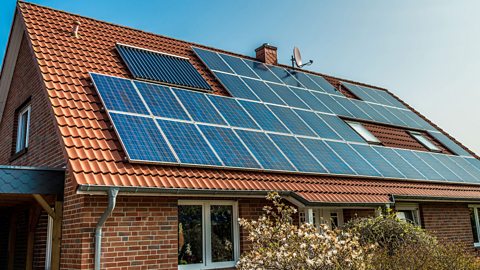
Advantages and disadvantages of solar power
Advantages
Solar power is a renewable energy resource.
There are no fuel costs.
Solar power does not release any carbon dioxide.
Disadvantages
It is an unreliable energy resource. It is dependent on the weather and how many hours of sunlight there are.
Solar panels are expensive to fit.
Renewable energy - biomass
Biomass is an energy resource from animal or plant material, for example wood or food waste. It is a renewableEnergy resources that can be easily replenished or are effectively limitless. These resources will not run out by being used. Solar power is an example of a renewable energy resource. energy source.
The biomass is burnt and this can be used to turn water into steam. The steam turns turbineRevolving machine with blades that are turned by wind, water or steam. Turbines in a power station turn the generators.. The turbines drives electrical generatorDevice that is made to rotate by mechanical working. It transfers energy out by electrical working. .
Biomass can be converted into liquid fuels known as biofuels such as biodiesel and ethanol. These may be used instead of petrol in vehicles.
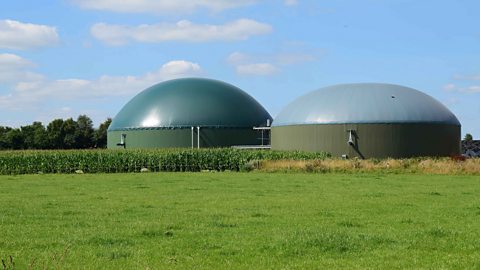
Advantages and disadvantages of biomass
Advantages
Biomass is a renewable energy resource.
Burning biomass and biofuels are carbon neutral. This means that the amount of carbon dioxide released when they are burned is the same as the amount which was absorbed by the plants when they were growing.
Disadvantages
When some biofuels are burned, the smoke can contain tiny particles of carbon which can cause breathing problems for people.
Lots of land is needed for growing the fuel crop.
Non-renewable energy - fossil fuels
Fossil fuels are an example of a non-renewable energy resource. Fossil fuels take a very long time to form so they are being used up faster than they can be replaced.
Coal, oil and natural gas are all fossil fuels. They are formed over millions of years from the remains of dead organisms.
Fossil fuel power stations generate electricity by burning fuel (coal, oil or natural gas). Energy transferred by heating causes water to boil, turning it into steam. The steam then turns a turbineRevolving machine with blades that are turned by wind, water or steam. Turbines in a power station turn the generators. which turns a generatorDevice that is made to rotate by mechanical working. It transfers energy out by electrical working. .
Disadvantages and advantages of fossil fuels
Disadvantages
fossil fuelNatural, finite fuel formed from the remains of living organisms, eg coal, oil and natural gas. are finite and will therefore not last forever.
Fossil fuels are a non-renewable resourceA resource that will run out, e.g. oil, natural gas, coal. These sources cannot be replaced by nature in less than a human lifetime. resource. When burnt they release harmful gases including:
Carbon dioxide - a greenhouse gas which causes global warmingThe rise in the average temperature of the Earth's surface. and contributes to climate change.
Sulphur dioxide and nitrogen oxides which cause acid rain. This is a significant issue when burning coal.
Smoke from burning coal or oil contains lots of fine particles. These can cause smog and result in breathing difficulties.
Taking fossil fuels from the ground has a negative impact on the landscape and environment.
Advantages
Fossil fuels are a reliableA reliable energy resource can be used whenever it is needed. It doesn’t depend on the weather or time of day. resource.
Fossil fuels have a large amount of energy in the chemical energy store per kilogram.
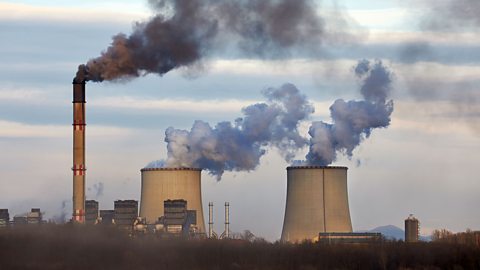
Non-renewable energy - nuclear fuel
reactorA piece of equipment in which nuclear fission or fusion takes place. is an example of a non-renewable resourceA resource that will run out, e.g. oil, natural gas, coal. These sources cannot be replaced by nature in less than a human lifetime. energy resource.
Nuclear power stations generate electricity using nuclear fuels, such as uranium and plutonium.
Energy in the nuclear store is transferred to energy in the thermal store through nuclear reactions. Energy is transferred by heating to boil water, turning it to steam. The steam then turns a turbineRevolving machine with blades that are turned by wind, water or steam. Turbines in a power station turn the generators. which then turns a generatorDevice that is made to rotate by mechanical working. It transfers energy out by electrical working. .
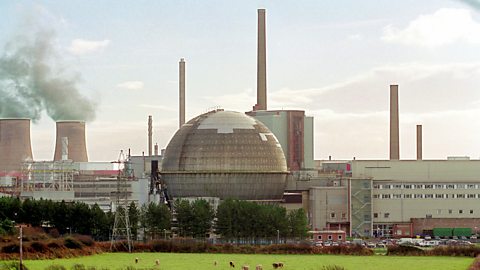
Disadvantages and advantages of nuclear fuel
Disadvantages
The reactorA piece of equipment in which nuclear fission or fusion takes place. needed for nuclear power stations will run out. Nuclear fuel is a finite resourceResource that is in limited supply. It will eventually run out due to us using it.. This means that nuclear fuels are a non-renewable energy resource.
Although a lot of research has been done on how to make nuclear power stations safe, if an accident occurs radioactive material may be released into the environment. This can cause cancers and therefore be hazardous to health.
Nuclear power stations also create a lot of nuclear waste. This harmful waste material can be radioactive for many thousands of years. It is important that it is stored correctly so that it is safe.
Advantages
Unlike fossil fuelNatural, finite fuel formed from the remains of living organisms, eg coal, oil and natural gas., nuclear fuels are not burnt. They do not cause smoke or release harmful gases which contribute to global warmingThe rise in the average temperature of the Earth's surface. and climate change.
Nuclear fuel has a high power output per kg of fuel. It is much higher than any of the fossil fuels. 1 kg of enriched uranium has the same power output as about 14,000 kg of coal.
Test your knowledge
Quiz
GCSE exam dates 2025
Find out everything you need to know about the 2025 GCSE exams including dates, timetables and changes to exams to get your revision in shape.

More on Energy
Find out more by working through a topic
- count3 of 7

- count4 of 7

- count5 of 7

- count6 of 7
